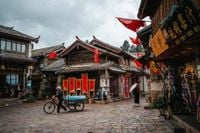As China entered its extended National Day holiday in October 2025, a striking contrast emerged between the country’s bustling railway stations and the simmering discontent beneath the surface of its local politics. While record-breaking crowds crisscrossed the nation—seeking rest, reunion, and a brief escape from daily pressures—protests and frustrations revealed deeper cracks in the Chinese Communist Party’s (CCP) grip on power, especially at the township level where governance meets the everyday lives of citizens.
On October 1, 2025, China’s national railway reported a staggering 23.13 million trips, according to state media outlet CCTV, marking an 8 percent increase from the previous year and setting a new single-day record. The Yangtze River Delta Railway alone was expected to ferry 4 million passengers the following day, a jump of more than 10 percent from 2024, as reported by Reuters. The Ministry of Transport projected a total of 2.36 billion passenger trips nationwide during the eight-day National Day holiday, with a daily average of 295 million journeys—a 3.2 percent rise compared with the same period last year. These numbers, bolstered by the holiday’s extension (thanks to the overlap with the Mid-Autumn Festival), underscored the authorities’ hopes that this travel surge would inject some much-needed life into domestic spending amid sluggish economic growth.
Yet, as millions traveled, a different kind of movement was spreading across the country. Protests flared in cities and towns, with citizens throwing pots at police and blocking highways, as reported by The Epoch Times. October 1 didn’t just mark the start of the holiday; it was also the 76th anniversary of the CCP’s rule, a date that drew global calls for change and emboldened dissent within China’s borders. Protesters worldwide rallied against the regime, and at home, frustration with Beijing’s iron grip became increasingly visible.
“China’s macro economy is staggering,” noted expert Michael Balding, capturing the mood of uncertainty that hung over the festivities. While the government hoped that record travel would signal renewed consumer confidence, many observers saw the underlying economic woes and political tensions as symptoms of a deeper malaise.
To understand this malaise, one must look beyond the headlines and into the engine room of Chinese governance: the township governments. According to an analysis published by The Diplomat, more than 85 percent of Chinese government spending flows through local governments, with township officials shouldering critical responsibilities such as education, healthcare, and public welfare. But the realities of township politics paint a picture of stagnation and frustration, especially for the young cadres who staff these vital institutions.
Township governments are led by a trio of section-level officials: the CCP secretary, the mayor, and the chief of the Township People’s Congress (often a former party secretary approaching retirement). Below them are about ten vice section-level leaders—vice secretaries, vice mayors, and various office heads—who, despite their titles, find themselves in a career cul-de-sac. Promotion to these roles is relatively straightforward for most cadres, provided they avoid major mistakes, but advancement beyond this point is exceedingly rare. Age cutoffs for promotion to vice section or section levels are typically set at 40, and sometimes as early as 35, according to interviews cited by The Diplomat. A recent directive from the Organization Department now requires newly promoted vice section leaders to wait three years before being considered for further elevation, and if they are rotated to a new township during this period, the clock resets. The result? Many ambitious young officials find themselves trapped—what one cadre called a “black hole for young cadres.”
Even those who reach the coveted section-level posts face fierce competition for advancement, with only about ten vice division-level positions available at the county level, and appointments often hinging on personal connections rather than merit. As a result, more than 70 percent of surveyed officials in Zhejiang province reported knowing their terminal position early in their careers, leading many to opt out of the promotion race altogether.
For some, the only motivation left is the hope of “escaping the township” for a reassignment to the county government—closer to their families and better amenities. For others, the lure lies in the real power wielded at the township level, where the top official enjoys significant authority and, in some cases, opportunities for personal enrichment. But as promotion prospects dwindle, the system breeds cynicism and inertia. “Everyone is stuck,” one cadre summed up—a sentiment echoed throughout the local bureaucracy.
The stagnation isn’t limited to ranked officials. Township governments often rely heavily on contract workers, who sometimes outnumber official bianzhi staff. These contract workers, while lacking in benefits and receiving lower wages, are often more competent and possess specialized knowledge of local conditions. One official admitted, “Before I met with contract workers, I looked down on them. I thought their role was to assist me. After working with them, I realized that I am the one here to assist them. I can’t do their job. Their jobs are incredibly challenging, and they possess skills that I don’t have. My role is to support them in what they do.”
Despite their value, contract workers face significant precarity. In some Guangxi townships, delays in salary payments have stretched beyond four months as of October 2025, fueling resentment and open defiance. When a local leader assigned new tasks to unpaid workers, one contract employee retorted, questioning why she should work without pay. Others have pushed responsibilities onto better-compensated officials, highlighting the growing divide within township administrations. While contract workers enjoy more freedom from political scrutiny and cumbersome meetings, their lack of job security and benefits makes them particularly vulnerable as local governments grapple with fiscal shortfalls.
Meanwhile, the restlessness in society is not confined to government offices. Protesters have taken to the streets, not only to air grievances about local governance but also to challenge the CCP’s broader authority. The disappearance of a Chinese diplomat and the subsequent appointment of a spy agent to fill the role (as reported by The Epoch Times) signaled a possible hardening of Beijing’s diplomatic posture. Protesters also called out companies like Luckin Coffee as potential CCP data risks, reflecting the intersection of politics, business, and privacy concerns in the digital age.
Internationally, the United States announced a $625 million investment to keep coal plants open, aiming to counter China’s advances in artificial intelligence, while Taiwan accused Beijing of laying the legal groundwork for an attack—a reminder that the tensions within China are mirrored by geopolitical friction abroad. Domestically, new restrictions capped bankers’ overseas travel to once a year, illustrating the leadership’s tightening control over both capital and personnel.
Amid these crosscurrents, the National Day holiday became a microcosm of China’s contradictions: record travel and consumer activity on the surface, but underneath, a society grappling with stagnation, discontent, and the limits of an aging political system. As one cadre put it, the CCP’s resilience depends on the vitality of its grassroots. If local governments decay, the consequences could ripple far beyond the township gates, shaping China’s future in unpredictable ways.





